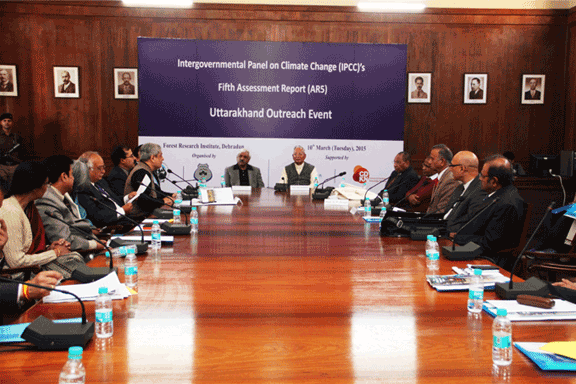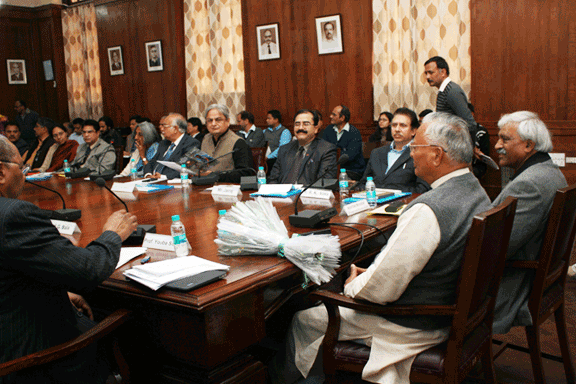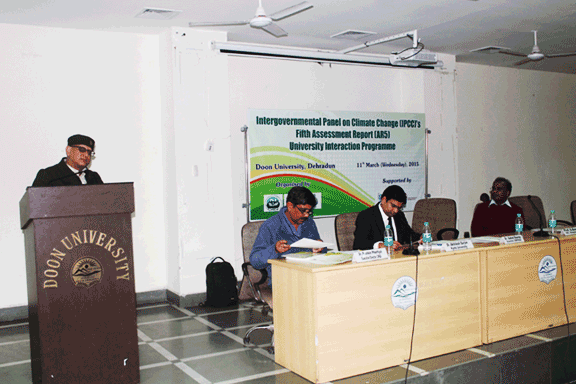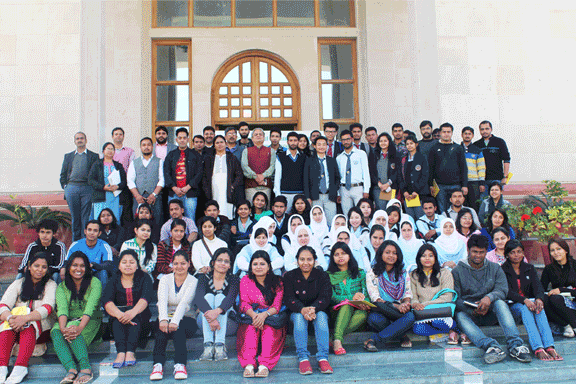IPCC's AR 5 shared with the Mountain Communities in India
Asia has seen steep rise in CO2 emissions in the last decade, CO2 emissions by 2100 could more than double from today while Rainfall Change (2081-2100) indicates a patter where rich rainfall get richer & poor rainfall regions get poorer. Under high CO2 emissions, Temperature may increase by 4-6 deg Celsius in Uttarakhand while Indian monsoon precipitation is projected to increase by the end of this century. The scenario of world clearly indicates that climate change is a global commons problem that requires international cooperation and coordination across scales and the Green House Gases (GHG) emissions growth has accelerated despite reduction efforts.
This were the key findings of Intergovernmental Panel on Climate Change (IPCC), a body working auspicious of United Nations, Assessment Report 5 in the IPCC Uttarakhand Outreach High Level Public event was organised by Climate Development and Knowledge Network (CDKN) supported by Foreign office of United Kingdom, Central Himalayan Environment Association (CHEA) and in participation with Forest Department, Uttarakhand. This was first time when IPCC AR 5 reached out to sub-national levels in the country.
Chief Guest of the event Mr. Govind Singh Kunjwal, Speaker of Uttarakhand Legislative Assembly stressed the need to increased sharing among science and policy. He appreciated the efforts made by CDKN, CHEA and Uttarakhand Forest Department in this direction and by brining IPCC authors to the state, Mr. Kunjwal further suggested that on the lines of IPCC Assessment Report there should be efforts by Scientist working for Himalayan region to develop assessments report for this region, which will give policy makers a firm base to plan and implement schemes for adaptation to climate change as well actions contributing in mitigation. He further said that climate change is a reality and Himalayan region including Uttarakhand state are one of the most vulnerable region to receive impacts. In the wake of climate change efforts are needed for ADMIT the combination of adaptation and mitigation approaches as it is clear that opting for only one of the approaches is not going to help.
Speaking at the event Guest of Honour and Minister for Forest and Environment Dinesh Agrwal said Uttarakhand state has strong social capital in the form of 12,500 Van Panchayats (VP) or community managed forests covering more than 0.5 million ha that accounts for almost 16% forest area of the state. Community forestry is seen as a cost effective means of dealing with forest degradation and management in the Himalayas and the Communities in the state have been highly successful in terms of forest conservation at local level. However, appropriate design and planning will be required to take advantage of REDD+ to protect vulnerable communities and their forest Agarwal added.
According the Minister at present the entire forest area of Uttarakhand has about 0.5 billion ton carbon in biomass and soil, which is nearly 25% of the annual carbon emission of India's 1.2 billion populations through fossil fuel combustion. The Uttarakhand forests sequester Carbon at the rate of about 7 Million ton per year, which is roughly worth Rs. 3.5 billion. A study by CHEA in Van Panchayats, in Lamgarha block, Almora district shows the panchayati forests sequester Carbon at the rate of 3to 4 ton per hectare per year in addition to meeting people's daily needs of biomass: firewood, livestock, fodder and litter the source of nutrients to agricultural fields and then serving as community livelihoods. Sharing his concern he said if people fail to maintain their existing forests because of the lack of any economic support, the soil carbon pool would also be lost. Proper policies, therefore, need to be framed and implemented to reap the maximum benefit from the forest carbon stocks of Himalayan states like Uttarakhand, he added. Mr. Agarwal also shared plans to form a committee to plan and monitor climate change related projects and programmes in the state.
IPCC was represented by Dr. Youba Sokona, Co Chair Working Group III and authors Dr. Akhilesh Surjan, Associate Professor, Kyoto University, Japan, Lead Author, IPCC's WGII, Prof. Govindasamy Bala, Indian Institute of Science, Bangalore. These three experts represented IPCC WG I that assesses the physical science basis of climate change; WGII assesses impacts, adaptation, and vulnerability while the WG III assesses the mitigation of climate change.
The suggested way ahead included More IPCC-type robust studies for specific geographies such as Himalayan Region; Sub-national/state universities, research institutions, civil society, tiers of government and communities (TK/IK) collaborating in innovative ways to clearly understand ad-hoc adaptation, mal-adaptation as well as smart-adaptation; Up-scaling ongoing pilot projects having successful results; and synergy among actors across scales and disciplines.
Chairing the technical session Chief Secretary, Uttarakhand N Ravishakar said that it is a welcome step that the findings and recommendations of AR5 are now being shared at sub-national level and now it becomes a responsibility of policy makers to plan right policies and implement them. While Indu Kumar Pnade, Advisor to Chief Minister Charing the Stakeholder session suggested using the traditional knowledge with the community for adaption efforts. Additional Principal Conservator of Forest Jai Raj gave an overview of the purpose of the outreach event and shared the State Action Plan on Climate Change of Uttarakhand has been endorsed by the technical committee of Government of India and soon will get final approval.
The three presentations made by IPCC authors highlighted that the actual measurements of climate parameters suggest that the earth is warmer today than it was a century ago by 0.74oC on an average basis and twelve of the last thirteen years have been the warmest on record. While there is debate about the quantum of change in climate parameters in the decades to come because of limitations of models used to simulate and predict the rate of change as well as the multitude of models leading to a construction of multiple scenarios, there is little debate about the direction in which various parameters are headed. It is widely believed that in the years to come earth will warm at a faster rate, sea-levels will rise further, extreme weather events will become more frequent and intense, and global reserves of ice will dissipate. It was further shared by the authors that While these changes take place, some areas will be worse hit than others and the Himalayas are believed to be among the most vulnerable to climate change.
Dr. Pushkin Phartiyal, Executive Director of CHEA shared that under the Uttarakhand outreach event a dedicated programme for University students and researchers was organised on March 11 at Doon university in which 250 students from various universities and institutions participated and got the chance to interact with the IPCC authors Prof. Govindasamy Bala and Dr. Akhilesh Surjan along with IPCC reviewer Dr. A. K. Gupta, Director of WIHG.
The participants of High Level Public event included Ms Vibha Puri Das, Dr. Rakesh Shah, Chairman State Biodiversity Board, APCCF S.T. S. Lepcha, Dr. U Rawat, Dr Rajendra Dobhal, Vineet Pangti, Dr R.K Maikhuri Dr Subrat Sharma, Dr Harshwanti Bisht, Dr Rajendra Singh, Dr. Mustafa of IHCAP and representatives of various universities, institutions and civil society organisations. Senior Advisor of CDKN Mihir Bhatt thanked the participants for their active involvement and assured the state government to extend required technical and scientific support to combat climate change impacts.




